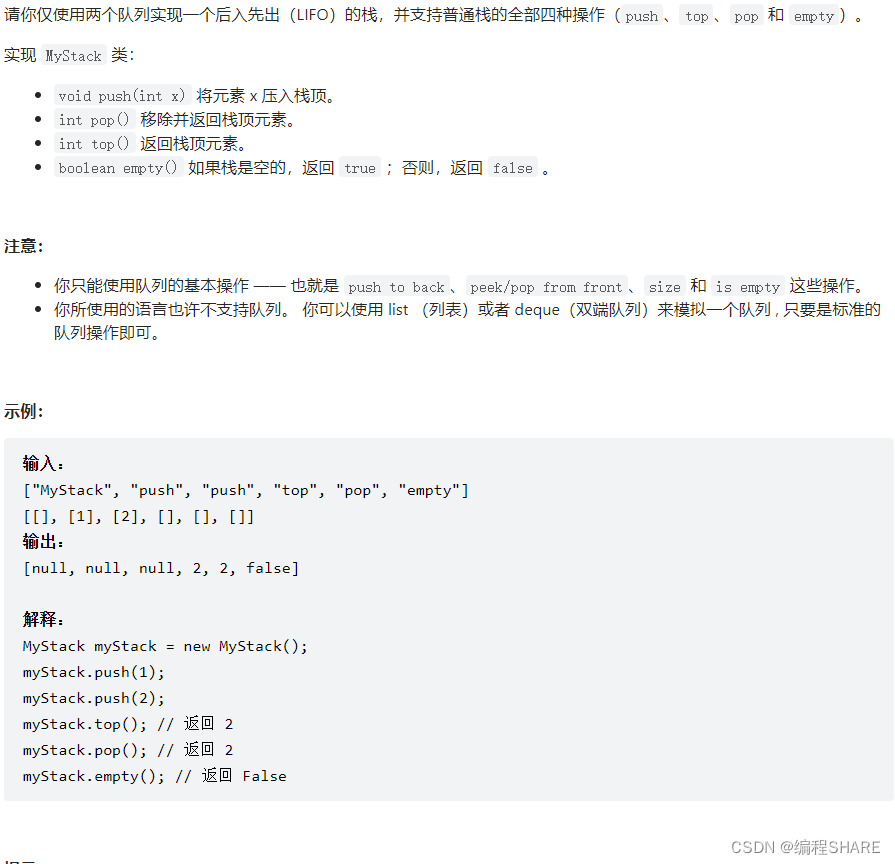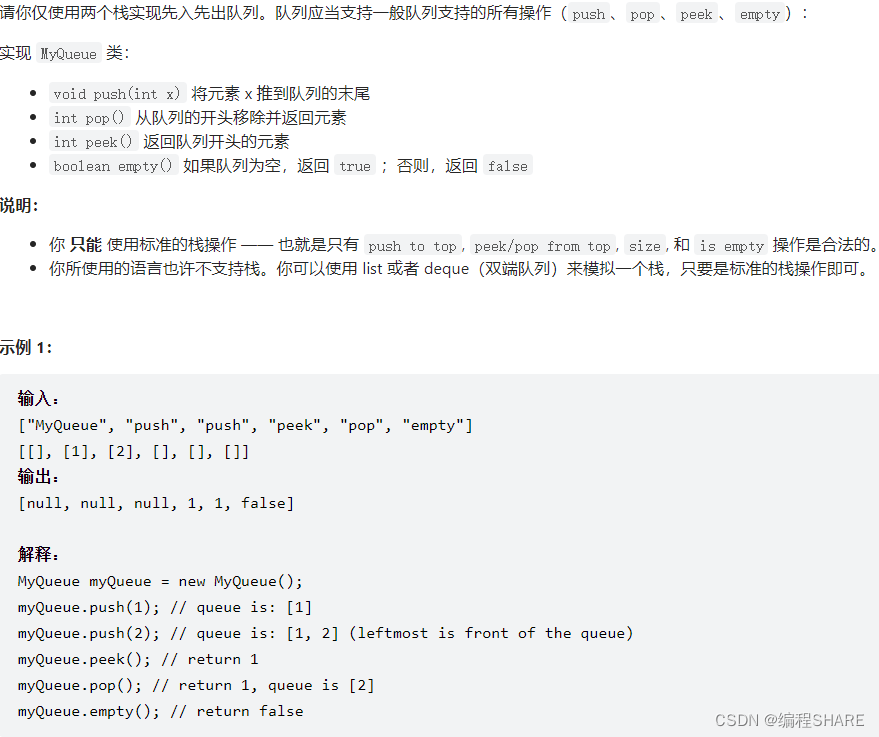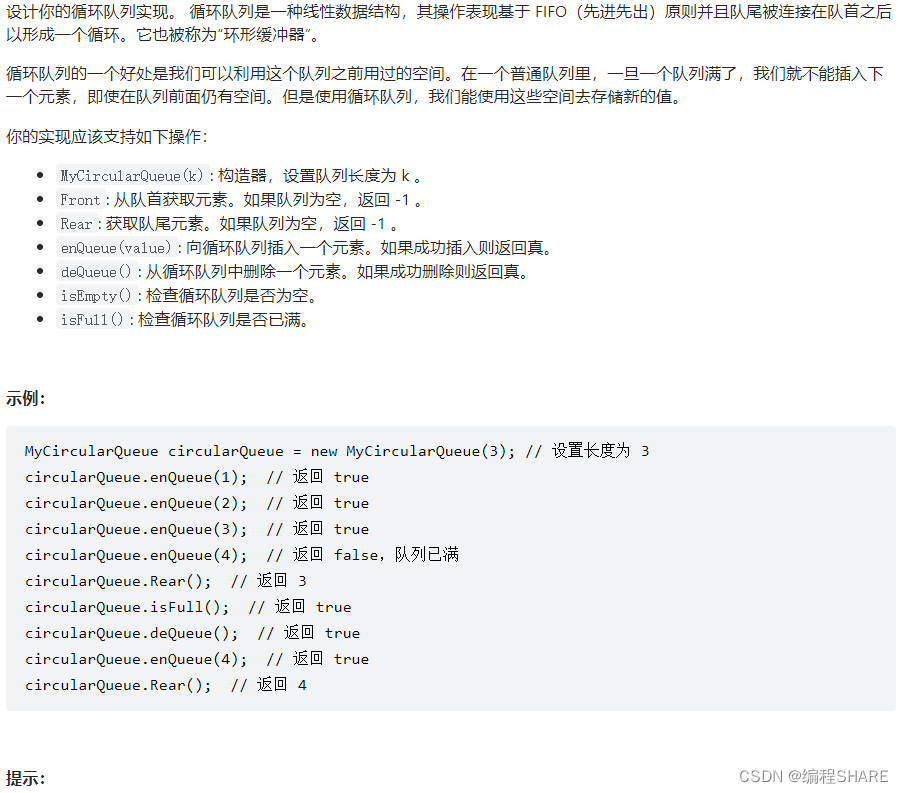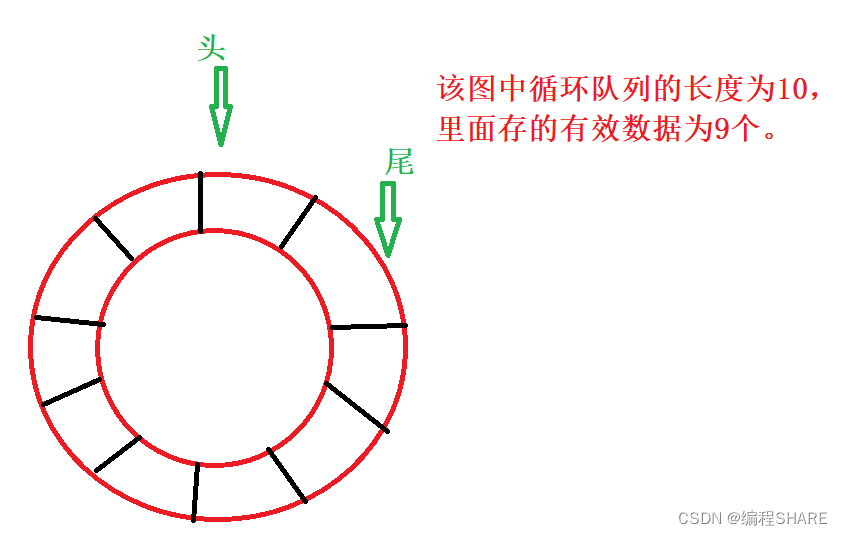栈与队列
225.用队列实现栈

解题思路
队列的性质是先进的先出,栈的性质是先进是后出。
我们设计的这两个队列,当添加数据的时候,插入有数据不为空的一个队列。当删除数据的,把数据移动到为空的队列中去,只留下队尾的数据,该数据就是要删除的数据。
代码
下面这是创建队列
typedefint QueueTypeDate;typedefstructQListNode{structQListNode* next;
QueueTypeDate val;}QNode;typedefstructQueue{
QNode* head;
QNode* tail;}Queue;voidQueueInit(Queue* q){assert(q);
q->head = q->tail =NULL;}
bool QueueEmpty(Queue* q){assert(q);return q->head ==NULL;}voidQueuePush(Queue* q, QueueTypeDate x){assert(q);
QNode* newnode =(QNode*)malloc(sizeof(QNode));
newnode->next =NULL;
newnode->val = x;if(QueueEmpty(q))
q->head = q->tail = newnode;else{
q->tail->next = newnode;
q->tail = newnode;}}voidQueuePop(Queue* q){assert(q);assert(!QueueEmpty(q));if(q->head == q->tail){free(q->head);
q->head = q->tail =NULL;}else{
QNode* next = q->head->next;free(q->head);
q->head = next;}}
QueueTypeDate QueueFront(Queue* q){assert(q);assert(!QueueEmpty(q));return q->head->val;}
QueueTypeDate QueueBack(Queue* q){assert(q);assert(!QueueEmpty(q));return q->tail->val;}intQueueSize(Queue* q){assert(q);
QNode* cur = q->head;int size =0;while(cur){
size++;
cur = cur->next;}return size;}voidQueueDestroy(Queue* q){assert(q);while(q->head){QueuePop(q);}}
队列实现栈
typedefstruct{
Queue Q1;
Queue Q2;} MyStack;
MyStack*myStackCreate(){
MyStack* obj=(MyStack*)malloc(sizeof(MyStack));QueueInit(&obj->Q1);QueueInit(&obj->Q2);return obj;}voidmyStackPush(MyStack* obj,int x){if(QueueEmpty(&obj->Q1))QueuePush(&obj->Q2,x);elseQueuePush(&obj->Q1,x);}intmyStackPop(MyStack* obj){int x;if(QueueEmpty(&obj->Q1)){while((&obj->Q2)->head!=(&obj->Q2)->tail){
x=QueueFront(&obj->Q2);QueuePop(&obj->Q2);QueuePush(&obj->Q1,x);}
x=QueueFront(&obj->Q2);QueuePop(&obj->Q2);}else{while((&obj->Q1)->head!=(&obj->Q1)->tail){
x=QueueFront(&obj->Q1);QueuePop(&obj->Q1);QueuePush(&obj->Q2,x);}
x=QueueFront(&obj->Q1);QueuePop(&obj->Q1);}return x;}intmyStackTop(MyStack* obj){if(QueueEmpty(&obj->Q1))returnQueueBack(&obj->Q2);elsereturnQueueBack(&obj->Q1);}
bool myStackEmpty(MyStack* obj){returnQueueEmpty(&obj->Q1)&&QueueEmpty(&obj->Q2);}voidmyStackFree(MyStack* obj){QueueDestroy(&obj->Q1);QueueDestroy(&obj->Q2);free(obj);}
232.用栈实现队列

解题思路
一个栈来表示入队(简称入栈),另一个栈来表示出队(简称出栈)。当出队是,如果出栈为空,入栈里面的全部数据进入出栈中。
当查看队头的元素的时候,就是要察看出栈栈顶的数据。要注意出栈数据为空的情况。
代码
栈的实现——》数据结构——栈
typedefstruct{
Stack outstack;
Stack instack;} MyQueue;
MyQueue*myQueueCreate(){
MyQueue* obj=(MyQueue*)malloc(sizeof(MyQueue));InitStack(&obj->outstack);InitStack(&obj->instack);return obj;}voidmyQueuePush(MyQueue* obj,int x){StackPush(&obj->instack,x);}intmyQueuePop(MyQueue* obj){if(!StackSize(&obj->outstack)){while(StackSize(&obj->instack)){StackPush(&obj->outstack,StackTop(&obj->instack));StackPop(&obj->instack);}}int x=StackTop(&obj->outstack);StackPop(&obj->outstack);return x;}intmyQueuePeek(MyQueue* obj){if(!StackSize(&obj->outstack)){while(StackSize(&obj->instack)){StackPush(&obj->outstack,StackTop(&obj->instack));StackPop(&obj->instack);}}returnStackTop(&obj->outstack);}
bool myQueueEmpty(MyQueue* obj){return!(StackSize(&obj->instack)||StackSize(&obj->outstack));}voidmyQueueFree(MyQueue* obj){StackDestroy(&obj->outstack);StackDestroy(&obj->instack);free(obj);}
622.设计循环队列

解题思路
我们创建的循环队列为静态。队列长度为N,那么我们里面只用来储存N-1个数据。
队列里面的成员包括,数据,队列起始下标(头标),队列末尾下标(尾标),队列可以有效储存数据的长度。
我们这样设计循环队列:当头标和尾标相等时,队列为空;当尾标下一个坐标等于头标时,为满。
我们设计的队列本质是连续储存的数组。
当增加数据的时候,尾向后移动;当删除数据的时候,头向后走。
不为空的时候。头或尾到最后的边界的时候,要回到头的地方。
插入的时候注意满的情况,删除的时候注意为空的时候。
代码
typedefstruct{int* arr;int head;int tail;int capacity;} MyCircularQueue;
MyCircularQueue*myCircularQueueCreate(int k){
MyCircularQueue* obj=(MyCircularQueue*)malloc(sizeof(MyCircularQueue));
obj->arr=(int*)malloc(sizeof(int)*(k+1));
obj->head=obj->tail=0;
obj->capacity=k;return obj;}
bool myCircularQueueIsEmpty(MyCircularQueue* obj){return obj->head==obj->tail;}
bool myCircularQueueIsFull(MyCircularQueue* obj){int curtail=obj->tail+1;if(curtail==obj->capacity+1)
curtail=0;return curtail==obj->head;}
bool myCircularQueueEnQueue(MyCircularQueue* obj,int value){if(myCircularQueueIsFull(obj))return false;
obj->arr[obj->tail]=value;
obj->tail++;if(obj->tail==obj->capacity+1)
obj->tail=0;return true;}
bool myCircularQueueDeQueue(MyCircularQueue* obj){if(myCircularQueueIsEmpty(obj))return false;
obj->head++;if(obj->head==obj->capacity+1)
obj->head=0;return true;}intmyCircularQueueFront(MyCircularQueue* obj){if(myCircularQueueIsEmpty(obj))return-1;return obj->arr[obj->head];}intmyCircularQueueRear(MyCircularQueue* obj){if(myCircularQueueIsEmpty(obj))return-1;int curtail=obj->tail-1;if(curtail==-1)return obj->arr[obj->capacity];elsereturn obj->arr[curtail];}voidmyCircularQueueFree(MyCircularQueue* obj){free(obj->arr);
obj->arr=NULL;free(obj);}
版权归原作者 编程SHARE 所有, 如有侵权,请联系我们删除。